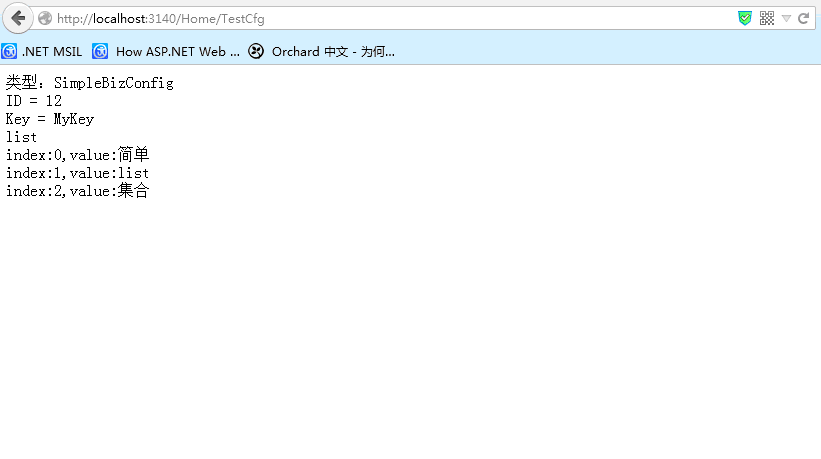我们经常会遇到这样的场景:
今天来了个业务,需要加一个字段,但是考虑的以后可能有变动,需要配成“活”的。
一般最初的做法就是加一个配置到Web.Config文件的AppSettings中去。但是这样有一个问题,那就是改一下配置节点,AppDomain就需要重启,很是不爽。
变通一点的会搞出一个xml文件,利用序列化去动态的读取。但是,哥!每次都读文件不觉得太耗IO吗?尤其是使用频率高话?
下面上代码吧,懒的废话了,关键地方都注释了,也不是什么高深的技术:
先来配置文件(注意Config路径要自己建,代码没有处理)和对应的配置文件代码:
class="brush:html;gutter:true;"><?xml version="1.0" encoding="utf-8"?> <SimpleBizConfig xmlns:xsi="http://www.w3.org/2001/XMLSchema-instance" xmlns:xsd="http://www.w3.org/2001/XMLSchema"> <ID>12</ID> <Key>MyKey</Key> <ListSimple> <string>简单</string> <string>list</string> <string>集合</string> </ListSimple> </SimpleBizConfig>
using System.Text;
using Glutton.Web.Configuration;
using System;
using System.Collections.Generic;
using System.Linq;
using System.Web;
namespace WebTest.Models
{
public class SimpleBizConfig : ISimpleConfig
{
/// <summary>
/// 默认配置文件路径
/// </summary>
public string GetPath()
{
return "~/Config/SimpleBizConfig.cfg";
}
public string GetCacheKey()
{
return "~/MyConfig_SimpleBizConfig";
}
public SimpleBizConfig()
{
this.ID = 1;
this.Key = "MyKey";
this.ListSimple = new List<string>();
}
public int ID { get; set; }
public string Key { get; set; }
public List<string> ListSimple { get; set; }
internal string Desc()
{
StringBuilder sb = new StringBuilder();
sb.Append("类型:SimpleBizConfig").Append("<br/>");
sb.Append("ID = " + this.ID.ToString()).Append("<br/>");
sb.Append("Key = " + this.Key).Append("<br/>");
sb.Append("list").Append("<br/>");
for (int i = 0; i < this.ListSimple.Count; i++)
{
sb.Append("index:" + i.ToString() + ",value:" + ListSimple[i]).Append("<br/>");
}
return sb.ToString();
}
}
}
再来管理配置文件的类:
using System; using System.Collections.Generic; using System.IO; using System.Linq; using System.Runtime.InteropServices; using System.Text; using System.Threading.Tasks; using System.Web; using System.Web.Caching; using System.Xml.Serialization; namespace Glutton.Web.Configuration { public interface ISimpleConfig { string GetPath(); string GetCacheKey(); } public class ConfigManager { public static T GetConfig<T>() where T : class ,ISimpleConfig, new() { T tmpT = new T(); string cacheKey = tmpT.GetCacheKey(); //先尝试从cache中取数据 T t = GetFromCache<T>(cacheKey);//很郁闷,没有静态泛型接口 if (t != null) { return t; } //cache没有数据,直接读配置文件 XmlSerializer xmlSerializer = new XmlSerializer(typeof(T)); string configFilePath = HttpContext.Current.Server.MapPath(tmpT.GetPath()); if (!File.Exists(configFilePath)) { //文件不存在,初始化,这里需要配置文件类实现默认的初始化动作 using (TextWriter writer = new StreamWriter(configFilePath)) { t = new T(); xmlSerializer.Serialize(writer, t); } } else { using (FileStream fs = new FileStream(configFilePath, FileMode.Open)) { t = xmlSerializer.Deserialize(fs) as T; } } //存到缓存里面去,依赖web缓存的文件依赖功能实现监控配置文件修改 SetToCache<T>(cacheKey, configFilePath, t); return t; } private static void SetToCache<T>(string cacheKey, string configFilePath, T t) where T : class ,new() { HttpRuntime.Cache.Insert(cacheKey, t, new CacheDependency(configFilePath), //文件依赖过期 Cache.NoAbsoluteExpiration, Cache.NoSlidingExpiration, CacheItemPriority.NotRemovable, null); } private static T GetFromCache<T>(string cacheKey) where T : class ,new() { return HttpRuntime.Cache[cacheKey] as T; } } }
看看调用的方法,HomeController里面加了一个测试方法:
using System;
using System.Collections.Generic;
using System.Linq;
using System.Web;
using System.Web.Mvc;
using Glutton.Web.Configuration;
using WebTest.Models;
namespace WebTest.Controllers
{
public class HomeController : Controller
{
public ActionResult Index()
{
return View();
}
public ActionResult About()
{
ViewBag.Message = "Your application description page.";
return View();
}
public ActionResult Contact()
{
ViewBag.Message = "Your contact page.";
return View();
}
public string TestCfg()
{
return ConfigManager.GetConfig<SimpleBizConfig>().Desc();
}
}
}
看看效果,:-D:
